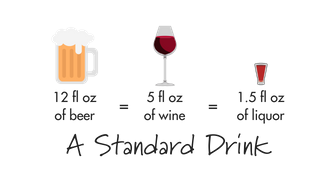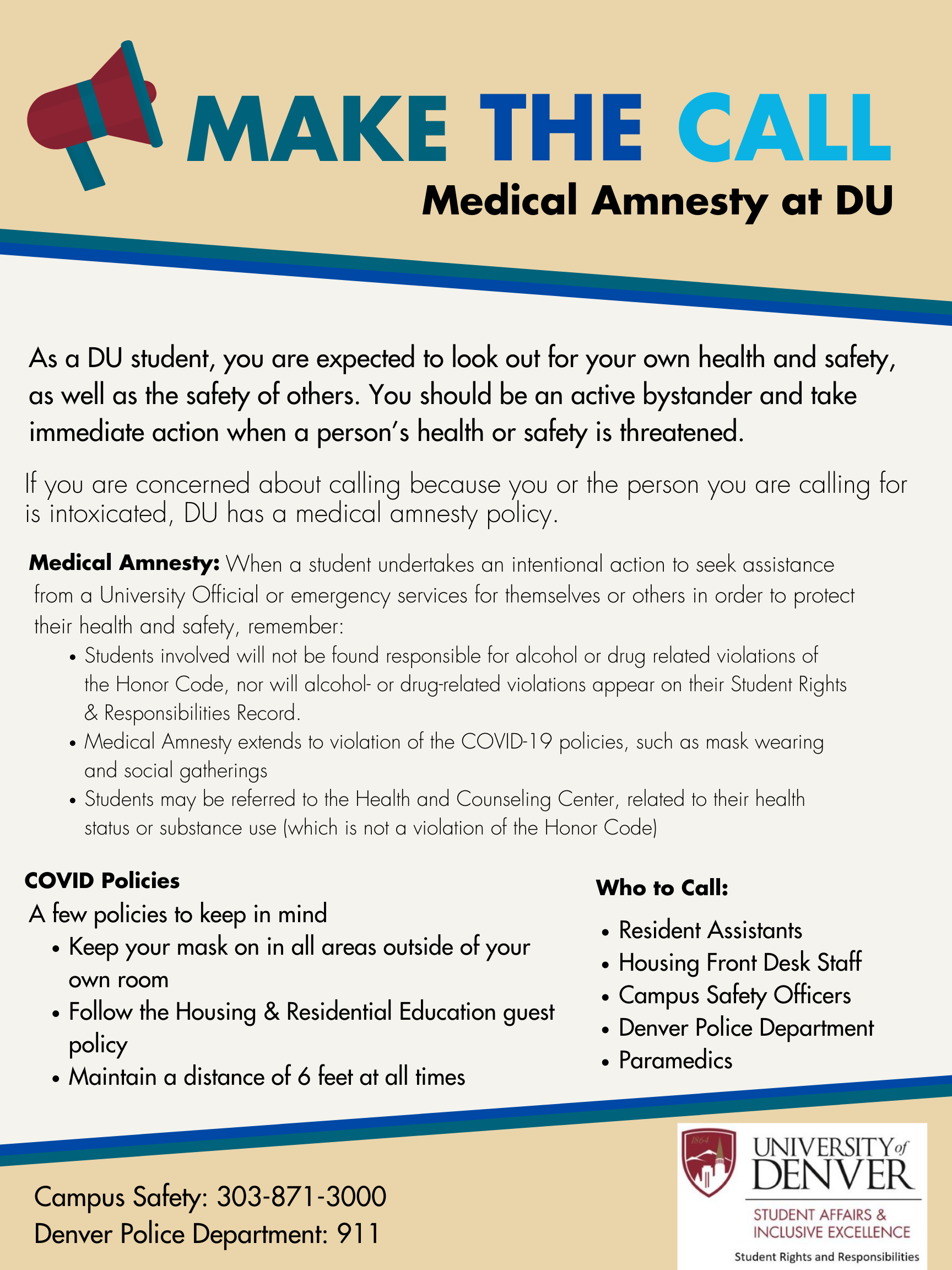Alcohol
Whether you choose to drink or not, knowing how alcohol can affect your body and mind, how to reduce negative outcomes, and what resources are available on campus will help you to make informed decisions as a contributing member of the DU community.
Drinking in College
While it may seem like everybody in college drinks, recent surveys show approximately 2,400 DU students did not drink any alcohol at all in the past 30 days. And of those students who do choose to drink, most imbibe moderately, sticking to four drinks or less.
To keep themselves and their friends safe, when DU students drink:
- 92% stay with the same group of friends when they go out
- 82% eat before and while drinking
- 71% keep track of how many drinks they've had
-
How Much Is One Drink?
Before you can use the number of drinks you've had to estimate how much alcohol is in your system, you need to know that one "standard" drink is defined as 0.6 ounces of pure alcohol. Because beer, wine, and liquor contain markedly different alcohol concentrations, standard drinks of each vary greatly in total volume.
Red party cups hold between 16 and 18 ounces, so if you fill one with beer, it likely contains 1.33 to 1.5 standard drinks. To better keep track, try to avoid pre-mixed punch drinks and pour your own.
-
Tips for Safer Use
The only way to avoid all potential harms from alcohol is to not use it. If you choose to drink, here are some ways you can lower your risk for potential harms:
- Abstinence is the most effective way to avoid any risk from substance use.
- Plan ahead. Think about the situation beforehand. Set a drink limit prior to going out.
- Keep track. This is the most basic technique to be aware of how much you have had to drink and know your limit (use can tabs, tallies on your hand, coins in your pocket, text yourself every time you have a drink).
- Slow down. Make note of how many sips it takes you to finish a drink. We recommend that you get at least 12 sips out of each drink. It could also help to add ice to make the drink last longer.
- Eat a meal before and/or while you drink to slow down the absorption of alcohol.
- Select different types of drinks. Choose drinks with less alcohol in relation to their volume (e.g., beer or wine vs straight liquor).
- Substitute or alternate non-alcoholic beverages. Alternate with water or soda. No one will know if your drink doesn’t have alcohol in it.
- Space your drinks. Making your drinks last longer will allow more time to pass between finishing one drink and starting another one.
- Know what you’re drinking. It can be difficult to know how much alcohol a drink contains if you don’t pour it yourself.
- Keep an eye on friends. When going out with friends, make sure to stay and leave together. Have a designated driver/person who will stay sober the entire time to watch out for one another.
- Have a backup plan. If something goes wrong, such as it’s not safe for you or anyone in your group to drive home or your group left you, have a backup plan like an Uber or another friend who would be willing to pick you up safely.
- Avoid rapid consumption drinking games.
- Avoiding paraphernalia used to facilitate rapid consumption of alcohol (beer bongs, funnels, etc.)
- Don’t accept drinks from people you don’t know or trust.
- Don’t leave a drink unattended, for any reason. Get a new one if you suspect something is wrong with it.
- Don’t mix alcohol and other drugs together, as combinations are dangerous and can be life-threatening.
- Don’t take prescription drugs that are not prescribed to you. See more information here.
- Trust your instincts. Check in with yourself if you are not feeling well or something doesn’t feel right in terms of your safety.
-
BAC Levels and Alcohol's Biphasic Effect
Blood alcohol content (BAC) is the percentage of alcohol in a person's blood. For example, if someone has a BAC of .06, their blood is .06% alcohol by volume. At BAC levels lower than .06, most people experience stimulant effects from alcohol such as mild euphoria, increased talkativeness, and feeling loosened up. However, alcohol is classified as a depressant drug with a biphasic effect — as BAC levels increase above .06, the stimulant effects become negated as alcohol slows down the heart, lungs, and brain.
- .07 – .09: Impaired balance, judgment, reasoning, and reaction time
- .10 – .12: More significant impairment, slurred speech
- .13 – .15: Dizziness, double vision, increased risk of injury to self and others
- .16 – .19: Nausea, "sloppy" drunkenness, mania, belligerence, spotty memory
- .20 – .24: Disorientation, vomiting, blacking out, risk of passing out
- .25 – .29: Severe mental, physical, and sensory impairment, passing out
- .30 – .34: Little comprehension, inability to stand or speak, coma/death possible
- .35 & up: Coma/death increasingly likely
-
What Is My BAC?
Knowing your approximate blood alcohol concentration can help you make more informed decisions. Several factors influence BAC, but it is mainly determined by your weight and how much you have had to drink.
Use this interactive BAC calculator to get a personalized estimate.
Please note that BAC calculators and charts are only able to provide estimates and do not account for all factors that might affect BAC. Remember, staying at a BAC of .06 or lower helps you avoid the depressant effects of alcohol and can help you and your friends stay safe.
-
Tolerance
How is it that some people can appear sober even after many drinks? They have likely built up a tolerance. Tolerance of alcohol indicates the body has adapted both physically and psychologically to its effects. However, it does not impact BAC itself, so while a person may appear to be functioning normally, their BAC may still be rising to harmful levels.
Tolerance can be dangerous because it causes people to lose awareness about their level of intoxication. For example, a person who has developed tolerance may feel like they are coordinated enough to drive when in fact their brain and body function are still impaired due to the amount of alcohol they had.
You can decrease tolerance by abstaining from alcohol or drinking less frequently.
-
Blacking Out
Alcohol has a deleterious effect on short-term memory. When BAC levels get high enough, the brain loses its ability convert short-term memories into long-term memories. This results in a blackout — a period, potentially lasting several hours, that is completely erased from the drinker's memory.
People experiencing blackouts remain conscious — they can still speak, drive, and make decisions. In fact, despite a very high level of intoxication, they can often seem less drunk. This is an extremely dangerous situation with potential consequences ranging from embarrassing to fatal, and everything in between.
Experiencing a blackout from drinking should serve as a serious, urgent warning. If you need help quitting or reducing your alcohol consumption, call the Health & Counseling Center at 303-871-2205.
-
Mixing Alcohol with Other Drugs
Alcohol is a depressant drug — it slows down your breathing, heart rate, and brain activity. When alcohol is used in combination with other drugs like stimulants, depressants, and cannabis, it can have a wide range of effects.
Alcohol and Stimulants
Some people take stimulants like cocaine and methamphetamine recreationally or to feed an addiction; some are prescribed stimulants like Adderall or Ritalin by a doctor to treat certain conditions; others simply use a mild stimulant like caffeine to feel more alert in the morning. When stimulants are used in combination with drinking, they can mask alcohol's intoxicating effects, making it harder to tell if you've had too much to drink. This can lead to poor decision making and dangerous situations, including overdose and death if your BAC gets too high.
Alcohol and DepressantsBecause alcohol is a depressant, mixing it with additional depressants like opioids or benzodiazepines will strengthen the depressant effects on breathing, heart rate, and brain activity. This can cause increased drunkenness, increased risk of passing or blacking out, and decreased breathing, which can lead to death.
Alcohol and CannabisCannabis can have a wide variety of effects on people. When combined with alcohol, its effects can be greatly intensified and even more unpredictable. For many, this combination causes significant drowsiness, dizziness, and confusion. For some, it can induce anxiety, panic, or paranoia.
-
Alcohol Poisoning
Alcohol poisoning refers to the acute negative effects of drinking a large quantity of alcohol in a relatively short time. These effects range from nausea to passing out to impaired breathing, coma, and death. If someone around you needs help because they've had too much to drink, follow these steps.
1. Check for signs of alcohol poisoning:
- Difficult or impossible to wake up
- Vomiting while asleep or barely awake
- Slow, shallow, or irregular breathing
- Cold, clammy, pale, or bluish skin
2. If any of these signs are present, call 9-1-1 and Campus Safety at 303-871-3000 or ext. 1-3000 right away.If a person is experiencing alcohol poisoning, their BAC will continue to rise until all the alcohol in their digestive tract has been absorbed, so you cannot assume someone will be okay just because they've been taken home.
-
Medical Amnesty
In any situation where you think somebody may need help, the best thing you can do is call 9-1-1 and Campus Safety at 303-871-3000 or ext. 1-3000 if you're on campus. Some students may be worried about getting in trouble, but DU's Medical Amnesty Policy says medical amnesty applies to the person who calls and the person for whom help is sought. It is important to know that:
- When a student undertakes an intentional action to seek assistance from a University Official or emergency services are sought for themselves or others, the students involved will not be charged with an alcohol- or drug-related violation of the Honor Code, nor will an alcohol- or drug-related violation appear on their record.
- Medical amnesty usually only applies to a student once.
Learn more about DU's Medical Amnesty Policy in the Honor Code.

